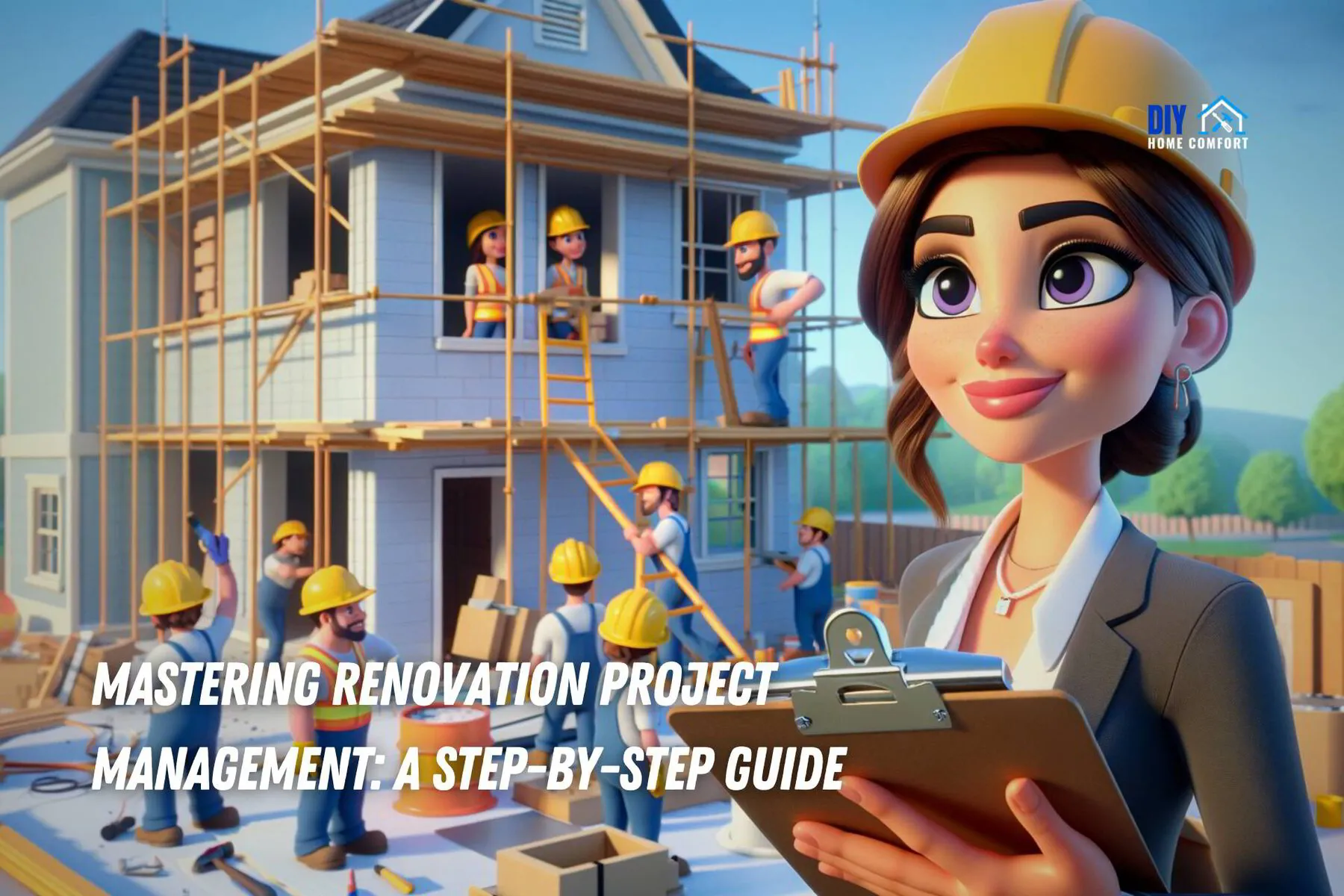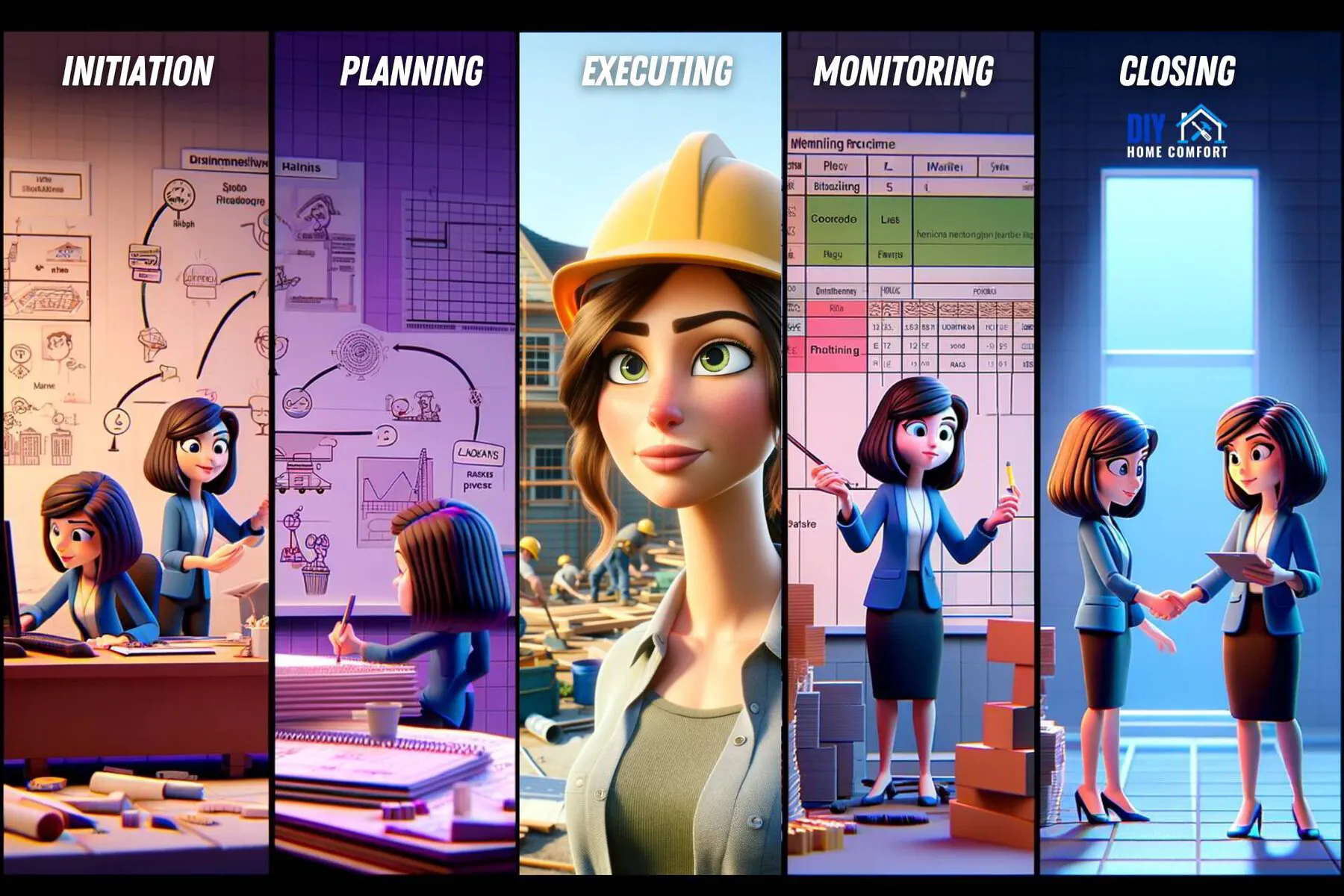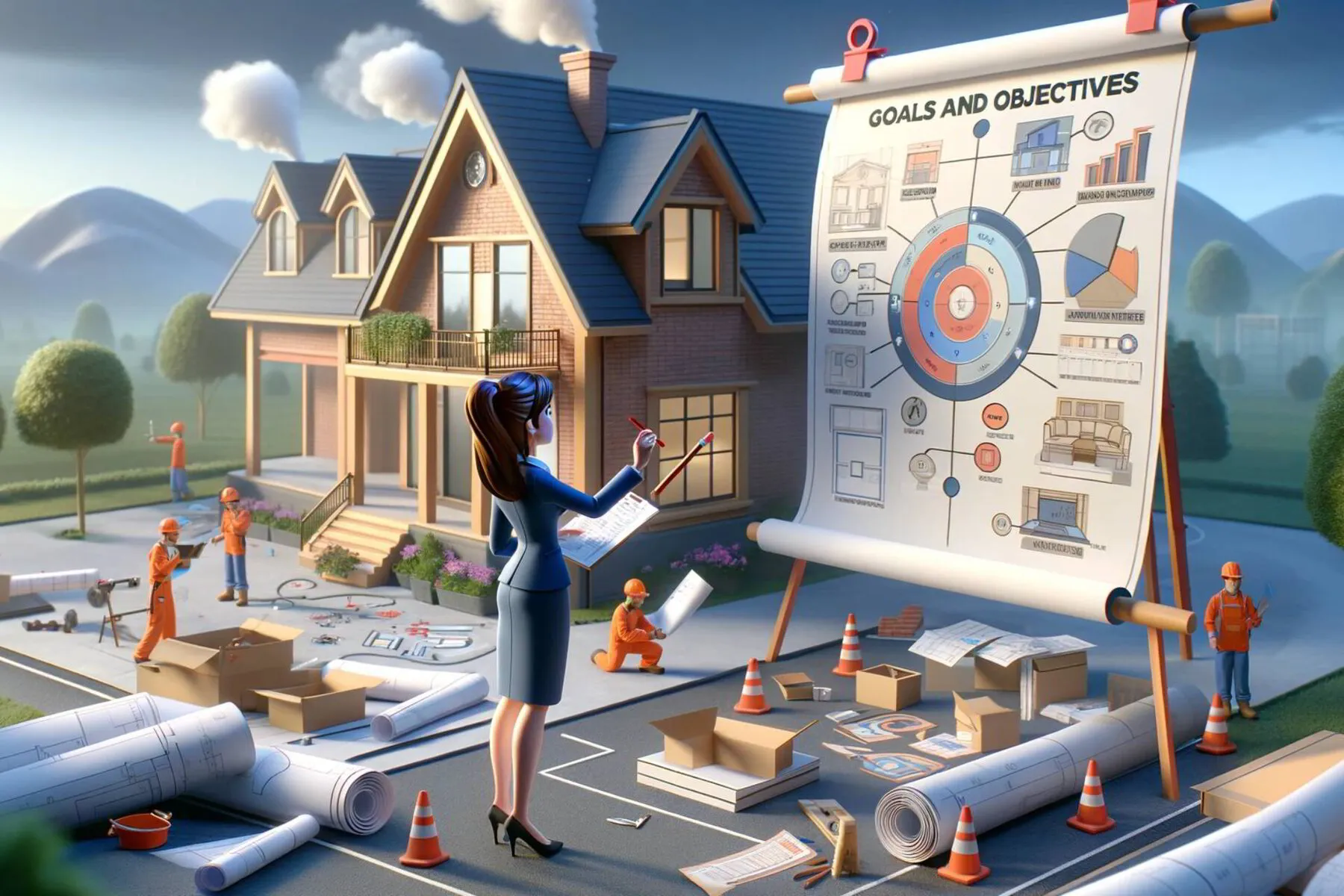Embarking on a home renovation journey can be both exciting and daunting for homeowners. It's a path to transforming your living space into the dream home you've always envisioned. However, effective renovation project management is the key to realizing these dreams.
This guide is crafted to navigate you through the complexities of renovating your home, from initial planning to the final touches. Whether it's a cozy kitchen upgrade or a full-scale home remodel, understanding the fundamentals of project management (PM) will empower you to make informed decisions, keep your home improvement project on track, and ensure a smooth and successful home transformation.
📘 Key Takeaways
- Effective Project Management: Homeowners must master project management to achieve successful home renovations, ensuring projects stay on budget and on schedule.
- Five Phases of Renovation PM: Initiation, planning, execution, monitoring and controlling, and closing are the five crucial phases homeowners should navigate for a smooth renovation journey.
- Budgeting and Resource Allocation: Careful budget planning, prioritization, and setting aside a contingency fund are essential to manage finances effectively during renovations.
- Working with Contractors and Designers: Clear communication, trust, and collaboration with professionals are vital in achieving the desired renovation outcomes.
- Monitoring Progress and Handling Challenges: Homeowners should track progress, adapt to changes, and stay calm when facing unexpected challenges during renovation.
- Leveraging Technology and Trends: Modern tools and apps can streamline project management while staying current with sustainable, open, and multifunctional design trends that enhance aesthetics and functionality.
⭐ Understanding Renovation PM
What is Renovation Project Management?
Renovation project management skillfully blends the art of vision with the science of execution to transform your home.
It involves guiding your renovation from a mere concept to a tangible reality, structured around the five key phases of project management: initiation, planning, execution, monitoring and controlling, and closing.
- Initiation: This is where your dream begins to take shape. As the first project manager's role, you define the project's purpose and scope, much like sketching a blueprint for your home's transformation.
- Planning: In this crucial phase, you develop a detailed plan that outlines every step of the renovation. It includes budgeting, scheduling, selecting materials, and deciding on design elements. This stage sets the foundation for a successful renovation, ensuring that every detail aligns with your vision.
- Execution: Here, the actual work begins. You coordinate with the builders and contractors, manage resources, and oversee the physical changes to your space. It's about bringing the plans to life, from demolition to reconstruction and installation.
- Monitoring and Controlling: Throughout the remodeling project, you'll need to track progress and adjust as needed. This phase ensures the entire project stays on track, within budget, and adheres to the planned timeline, much like a conductor fine-tuning the orchestra's performance.
- Closing: You wrap up the project in the final phase. This involves final inspections, addressing any remaining tasks, and ensuring that every aspect of the renovation meets your standards.
By navigating these five phases, renovation PM helps you make informed decisions, anticipate and overcome challenges, and maintain a smooth flow of activities. The result is a stress-free renovation experience and a home that not only meets but exceeds your expectations, enhancing your lifestyle in the process.
Importance for Homeowners'
Effective project management is key to a successful home renovation, impacting overall satisfaction and project success.
It ensures staying within budget through meticulous planning and expense tracking, thus avoiding financial strain from cost overruns. Timely completion is also vital, as good management minimizes life disruptions and prevents costly delays.
Furthermore, it guarantees the renovation meets the homeowner's aesthetics, functionality, and quality expectations. This is achieved through clear communication with contractors, judicious material selection, and detailed attention.
Ultimately, proficient project management is fundamental in realizing a home improvement project plan that beautifully aligns with the homeowner's vision and lifestyle needs.
⭐ Planning Your Home Renovation Project
Setting Goals and Objectives
Setting personal goals and objectives is a critical first step in any home renovation project. As a homeowner, defining what you want to achieve is important, as is ensuring your renovation aligns with your lifestyle, personal style, and family needs.
Here are key points to consider:
- Assess Your Needs: Think about what you need from your renovated space. Do you need more room for a growing family, an updated kitchen for better functionality, or a home office space?
- Define Your Style: Consider your personal style. Are you drawn to modern minimalism, cozy country, or classic elegance? Your renovation should reflect the aesthetics you love.
- Set a Budget: Determine how much you can realistically spend. This will guide your decisions on materials, finishes, and the project's scope.
- Prioritize: List the elements of your renovation in order of importance. If you can't do everything at once, decide what you need most.
- Think Long-Term: Consider how your needs might change in the future. A flexible design can accommodate evolving family dynamics or lifestyle changes.
- Energy Efficiency and Sustainability: If this is important to you, include eco-friendly materials and energy-saving features in your plan.
By setting clear, realistic goals and objectives, you can ensure that your renovation project not only adds value to your home but also enhances your quality of life.
Budgeting and Resource Allocation
Budgeting effectively is a cornerstone of successful home renovation. Here are practical tips to help homeowners manage their money and finances wisely during the renovation process:
- Create a Detailed Budget Plan: Start by listing all potential expenses, including materials, labor, permits, and unexpected costs. Allocate funds to each category based on quotes and research.
- Prioritize Spending: Focus your budget on structural renovations and high-impact areas like kitchens and bathrooms. These often offer the best return on investment.
- Get Multiple Quotes: Don’t settle for the first contractor quote. Compare prices to ensure you're getting fair, competitive rates.
- Set Aside a Contingency Fund: Reserve about 10-20% of your total budget for unforeseen expenses. Renovations often have surprises, and it’s wise to be prepared.
- Consider Phased Renovations: If budget constraints are tight, consider breaking the project into phases and tackling them over time.
- DIY What You Can: Simple tasks like painting or minor installations can be done yourself, saving labor costs.
- Reuse and Recycle: Where possible, repurpose existing building materials or buy second-hand items to cut costs without compromising quality.
- Energy-Efficient Choices: Investing in energy-efficient appliances and materials can lead to long-term savings on utility bills.
By carefully planning and allocating your budget, you can manage your home renovation expenses more effectively, ensuring a smoother renovation journey.
⭐ Executing Your Renovation Plan
Working with Contractors and Designers
Effective communication and clear expectations are key when working with contractors and designers. Start by selecting professionals with a strong portfolio and positive references. Look for those with experience in home improvement projects similar to yours who can understand your vision.
Once chosen, establish a clear line of communication. Be specific about your desires and listen to their professional advice. Regular meetings can help keep everyone on the same page. Trust is crucial, so while monitoring progress is important, avoid micromanaging.
Remember, a collaborative approach fosters a positive working relationship, leading to a more successful and satisfying renovation outcome.
Managing the Renovation Process
Managing a home renovation effectively involves staying organized and maintaining clear communication:
- Develop a Detailed Plan: Outline each phase, including timelines and key milestones.
- Use Project Management Tools: Employ calendars or digital tools to keep track of progress and deadlines.
- Regular Communication: Stay in constant contact with your contractors and designers for updates and issue resolution.
- Organize Documentation: Keep all related documents, contracts, and receipts in an easily accessible location.
- Be Decisive Yet Flexible: Make timely decisions to avoid delays, but remain adaptable to unexpected changes.
- Conduct Regular Site Visits: Personally inspect the progress to ensure it meets your standards and vision.
These steps will help you effectively manage your renovation project, keeping it on track and aligned with your goals.
⭐ Monitoring Progress and Making Adjustments
Keeping Track of Progress
Homeowners can effectively monitor the progress of their renovation and stay on schedule with these simple strategies:
- Regular Check-ins: Schedule weekly meetings with your contractor to discuss progress, address any concerns, and review the upcoming week's plan.
- Visual Progress Tracking: Use a timeline or a chart to visually map out the stages of your renovation, updating it as tasks are completed.
- Photo Documentation: Regularly take photos of the renovation site to compare progress over time visually.
- Task Lists: Create and maintain a checklist of tasks and tick them off as they are completed, ensuring nothing is overlooked.
- Stay Informed: Ask your contractor to inform you immediately of any delays or issues that might affect the schedule.
Handling Changes and Challenges
Navigating unexpected changes and challenges during a renovation requires flexibility and a problem-solving mindset:
- Stay Calm and Analytical: Approach unforeseen issues calmly and analyze your options.
- Open Communication: Discuss any changes with your contractor and designer openly. Understand the implications, whether in cost, time, or design.
- Contingency Plan: Have a contingency budget and timeline for unexpected expenses or delays.
- Prioritize: If changes are necessary, prioritize them based on your needs and budget.
- Document Changes: Keep a record of all changes, including revised plans and additional costs.
- Seek Expert Advice: Don't hesitate to consult with other professionals for a second opinion or solutions.
⭐ Finalizing Your Renovation Project
Inspections and Final Touches
As your house renovation nears completion, final inspections and touches are crucial to ensure everything aligns with your plan:
- Schedule a Walk-Through: Conduct a thorough walk-through with your builder or contractor to identify any unfinished tasks or issues.
- Check Against Original Plan: Compare the completed work with the original plan and design specifications to ensure all elements are as agreed.
- Request Necessary Adjustments: If discrepancies are found, request the necessary adjustments or corrections.
- Professional Inspection: Arrange for a professional inspection to ensure all work complies with local building codes and standards.
- Add Personal Touches: Once the major work is approved, add your personal touches, such as decor, furnishings, and lighting, to complete the transformation of your space.
Enjoying Your Newly Renovated Home
With the renovation complete, it's time to step back and savor the transformation of your space. Reflect on your journey, from the initial vision to the final execution. Appreciate the effort and resources invested in creating a space that's uniquely yours.
Now, your home reflects your personal style and is a testament to your dedication and decision-making throughout the renovation process.
Enjoy the new comforts and functionalities, host gatherings to share the space with friends and family, and take pride in successfully completing your home renovation project. This rejuvenated space is now ready to create new memories and experiences.
⭐ Leveraging Technology and Trends in Home Renovation
Modern Tools and Apps for Homeowners
In today's digital age, homeowners embarking on renovation projects have a plethora of user-friendly tools and apps at their disposal, enhancing project management efficiency:
- Houzz: Great for inspiration; it offers design ideas and product information and connects you with local professionals.
- Pinterest: Ideal for organizing design ideas and visualizing different styles and concepts.
- HomeZada: A comprehensive app for budget tracking, project scheduling, and inventory management.
- Magicplan: Allows you to create and share interactive floor plans using your smartphone camera.
- Trello or Asana: These project management tools help in task scheduling, tracking progress, and collaboration with your renovation team.
Leveraging these tools can streamline your renovation and construction process, keeping you organized and informed every step of the way.
📘 Related Reading: Your DIY Guide to Home Improvement Project Tracking Tools
Current Trends in Home Renovation
Current home renovation trends focus on creating spaces that are not only aesthetically pleasing but also functional and sustainable.
Key trends include:
- Sustainable Living: Eco-friendly materials and energy-efficient appliances are increasingly popular, reducing environmental impact and utility costs.
- Smart Home Technology: Integrating smart devices for enhanced comfort, security, and energy management.
- Open Floor Plans: Knocking down walls to create open, airy spaces that foster social interaction and natural light flow.
- Multifunctional Spaces: Designing rooms that can serve multiple purposes, such as home offices or workout areas.
- Natural Elements: Incorporating wood, stone, and plants for a touch of nature and tranquility.
- Minimalist Aesthetics: Simplistic designs with clean lines and a neutral color palette for a timeless look.
These trends not only enhance the visual appeal of your home but also add to its functionality and long-term value.
⭐ Lessons Learned from Home Renovations
Navigating Budget Challenges
Budget challenges in home renovations often stem from unforeseen structural issues or volatile material costs. Homeowners may encounter hidden damages or required upgrades that weren't initially factored into the budget.
In such cases, successful resolution involves:
- Flexible Budgeting: Adjusting the budget to accommodate unexpected costs while maintaining a contingency fund.
- Prioritization: Reevaluating project priorities to address critical issues first, deferring less urgent improvements if necessary.
- Contractor Collaboration: Engaging in open communication with contractors to explore cost-effective solutions and alternatives.
- Research and Planning: Conducting thorough research before the project to identify potential issues and allocate resources accordingly.
These strategies help homeowners navigate budget challenges effectively and ensure their renovation stays on track without compromising quality.
Strategic Insights for Future Projects
Homeowners have gleaned valuable strategic insights from renovation experiences, emphasizing the significance of meticulous pre-project planning, comprehensive budgeting, and effective communication with contractors.
These lessons transcend individual projects and can greatly enhance future renovations:
- Pre-project Planning: Thorough research and planning mitigate surprises and allow for smoother project execution.
- Comprehensive Budgeting: Creating a detailed budget with contingency funds ensures financial flexibility in the face of unforeseen expenses.
- Effective Communication: Maintaining open and clear communication with contractors fosters collaboration and problem-solving, enhancing project outcomes.
By applying these overarching principles, homeowners can embark on future renovation projects with confidence, achieving their goals efficiently and with fewer challenges along the way.
The Bottom Line
In conclusion, successful home renovation is all about effective project management, involving clear goal-setting, detailed planning, and efficient execution.
Embracing modern tools and staying updated on current trends can significantly contribute to a smooth, stress-free renovation experience. While challenges may arise along the way, the right approach and careful preparation can help homeowners navigate them successfully.
For those seeking further insights and tips on DIY home improvement and comfort, we invite you to explore our articles on the topic. Discover valuable resources to enhance your home and create a space that truly suits your needs and preferences.
📘 Related Reading: Does Adding a Bathroom in the Basement Add Value?
Russell Jones
Russell Jones, VP of Operations at Phyxter Home Services, is a skilled home improvement specialist and insightful guest writer for DIY Home Comfort, offering practical and innovative ideas to homeowners. You can check out his other articles over at Phyxter.






